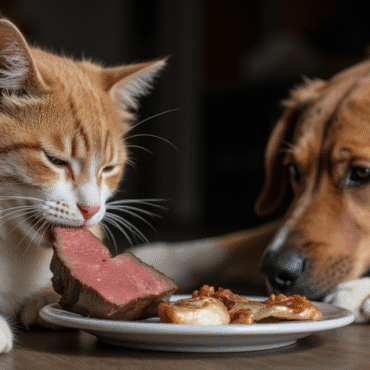
How Pet-Friendly Is Your Country?
Hi everyone, and thanks for joining me on this episode of Val Talk’s Pets. Here’s a question for you: How pet-friendly is your country, or even your town or city, […]

 play_arrow
play_arrowDog and Cat Trivia Challenge 1.3 Val Cairney

Hi everyone and thanks for joining me on this episode of Val Talk’s Pets. It’s time for another trivia challenge. Are you ready for dog and cat trivia 1.3? Grab your score card. Here we go!
Question: In terms of vocabulary how many words do you think a cat can learn or understand?
The answer is a bit vague actually. Apparently it is not as easy to measure how many words a cat can understand compared to a dog. For example, a cat will know its own name. Because it knows its name, there is no reason not to believe that they don’t know the names of other cats or dogs for that matter in their household.
Some people have been successful teaching a cat to communicate with language buttons by using food or some kind of rewards for picking the correct button to the item. I think if you are a cat parent you will know some of the words your cat knows.
My Rory knows his name, probably Tundra’s name, he knows, treats, he knows, go outside. He definitely knows, no, get down, stop that. He also knows, alley oop, I know that obviously has a back story.
So, as PetMD says, between 10 and 15 cue words is possible and I’m thinking that’s probably what Rory knows.

PetMD says that some of the common words a cat can learn are, “play, catnip, treat, water, walk and off”. I think most cats know that one. PetMD also suggests avoiding negative words like no or stop and substituting words like off or down. But, I think scratching the furniture is a hard no!
Tip: Remember never use a spray bottle of water to stop your cat from doing a certain behaviour. That’s a pretty antiquated practice and just makes the cat afraid of you.
Question: How many words can a dog understand or learn?
Answer: According to PetMD, “A 2022 study of 165 adult dogs found that according to their pet parents, dogs know an average of 89 words. But the range varied from as few as 15 words to as many as 215 words.”
The study revealed that amongst the words and phrases a dog knew, they included, “off, fetch, shake, and go get your….” Plus items like collar, ball, crate and vacuum. They also knew peanut butter, carrot, dinner and treat plus other foods.
Basically, dogs can have a level of word understanding equivalent to a 2 year old.
I was thinking about this as I read it and I guess that’s quite true with many of the words. For sure Tundra knows his name, and he knows, dinner, sit, paw, down, come, out, treats, put your toys to bed etc.
Summary:

Question: How many hours a day do you think your cat sleeps?
Answer: Cats will sleep an average of 12 to 16 hours a day. That is a lot of sleep!
Question: How many hours a day do dogs sleep?
Answer: Dogs will average 12 to 14 hours per day of sleep.
According to PetMD, certain breeds will sleep more or less than others. Working dogs like retrievers will tend to sleep less as they are hardwired to work. Bigger breeds and lapdog breeds tend to sleep more.
If you feel there are concerns with prolonged sleep, a trip to the vet can’t go remiss.
Question: Can cats taste sweet flavours?
Answer: No. PetMD states, “Researchers have discovered that cats, seemingly alone among the mammal groups, lack some of the proteins needed to create the gene that helps the body taste sweets.”
Cats actually only have about 500 taste buds. If your cat licks ice cream or yoghurt, they are more attracted to the fat than the sweet.

Question: Can dogs taste sweet?
Answer: Yes, they can. Dogs have about 1700 taste buds, while humans have about 9000.
According to PetMD, “Sweet flavours are especially preferred by dogs, which likely stems from their ancestral diet including wild fruits and vegetables.”
Question: Do cats fart?
Answer: Yes, but most cat farts are silent and odourless.
Passing a small amount of gas every now and then is perfectly natural. But, if it is excessive, then this could indicate a problem.”

Question: Do dogs fart?
Answer: Yes – and often with a strong smell!
Causes include:
Tip: Use probiotics with at least 9 strains and higher CFU counts (3 billion+ recommended).
Question: Why do dogs smell each other’s bums?
Answer: According to Rover, dogs can learn about gender, health, diet, age, and mood.
Question: Do cats smell bums?
Answer: Yes. According to VCA Hospitals, cats can learn if another cat is aggressive, ill, or familiar.
Cats also use head butting as a greeting, releasing pheromones that create a sense of familiarity and social bonding.
Well, we’ve completed another quiz. How did you do overall? I hope you did well and also picked up a tidbit or two. It’s always fun to see what our knowledge is when it comes to our pets.
And of course if you need to look further into any of these topics, do a little research and have some fun, because as I say, knowing is caring.
Would you like me to also format this into a blog/article style layout (like with bullet lists, bold highlights, and callouts for trivia questions) so it’s easier to post online, or keep it just like a podcast transcript with headings?

Tagged as: pet trivia, pet sleep habits, toxic foods for pets, cat vocabulary, dog behaviour, dog vocabulary, cat behaviour, pet podcast, cat trivia, dog trivia.
Hi everyone, and welcome to Val Talk’s Pets, the forum for pet parents and enthusiasts alike. So, I have been working in the pet industry now for almost 10 years and, on a daily basis, I handle a lot of issues and questions arising from pet parents. I am not a veterinarian but I do have certifications in Canine, Feline, Small Animal, Fish and Herptile and Avian Health and Nutrition from the University of California, Davis Extension, the Vet College.

Val Cairney September 19, 2025
Hi everyone, and thanks for joining me on this episode of Val Talk’s Pets. Here’s a question for you: How pet-friendly is your country, or even your town or city, […]


Val Cairney October 31, 2025
For the price of a coffee, or more if you are feeling generous, you can help keep this podcast going & growing. Please visit my ko-fi page to make a donation. Thanks!
all rights reserved - Val Talks Pets - 2024